DS Home DR installs, replaces and repairs all types of flooring from wood flooring to carpeting (Click Here to see a list of all the flooring we do) And we…
Specialize in both solid & Engineering Bamboo Flooring!
DS HOME DR only uses the best of the best when it comes to Bamboo Flooring for our clients. This is why we have partnered with CaliBamboo as our preferred source of Bamboo Flooring. They are the makers of the hardest floors in the world and their quality is unmatched in the marketplace.
Check out all their incredible Bamboo flooring products here – https://www.calibamboo.com/bamboo-flooring.html
Check out all there amazing flooring products here – https://www.calibamboo.com
Do you want more interesting facts about Bamboo go here – https://www.calibamboo.com/bamboo-facts/
Bamboo can be a great choice for environmentally conscious consumers. When handled properly, the flooring is sustainable and environmentally friendly. The processing of bamboo leaves little waste while creating an attractive wood floor. When comparing the pros and cons of bamboo flooring, the advantages far outweigh the disadvantages.
There are some concerns for the chemicals used in treating some plants, so choosing high quality flooring from reputable manufacturers is the best way to ensure the flooring has been made in a way that is as good for the environment as it is for the consumer. And while the best quality of bamboo flooring is made with environmentally friendly practices, unfortunately some companies do use methods that are less than ideal. These companies may use premature bamboo, which is less than four years old, and use high levels of additives like formaldehyde in the gluing process. While these practices do result in lower prices, they may also reduce the quality and negatively impact the environment.
So when deciding on which type of bamboo flooring to purchase, pay attention to the construction of the materials, the ends of the board to ensure there are no gaps in the layers of bamboo and that no fillers have been added to shore up gaps. The finish on the flooring should be coated evenly with a smooth and uniform texture.
Benefits of using bamboo flooring – www.calibamboo.com
Thanks to its unique composition, bamboo is naturally designed for strength…
- Unlike wood, bamboo has no rays or knots, allowing it to withstand more stress throughout the length of each stalk.
- Bamboo’s sectional anatomy, both as a cane and on a microscopic fiber level, enhances its structural integrity.
- The high silica content in bamboo fibers make the material difficult for termites to digest.
- Bamboo contains different chemical extractives than hardwood, which make it better suited for gluing.
- Trees used for conventional wood take 30-50 years to regenerate to their full mass. In the meantime, there is less oxygen produced, less carbon dioxide consumed, and more soil runoff in the spot where the tree was harvested – all producing harmful environmental effects. When it comes to sustainability, bamboo has traditional lumber beat in every category…
- Bamboo is clocked as the fastest growing plant on Earth. Some species have been measured to grow over 4 feet in 24 hours.
- A pole of bamboo can regenerate to its full mass in just six months!
Bamboo can be continuously re-harvested every 3 years, without causing damage to the plant system and surrounding environment. - During the time it takes to regenerate, the bamboo plant’s root system stays intact so erosion is prevented.
- Continuous harvesting of this woody grass every 3-7 years, actually improves the overall health of the plant.
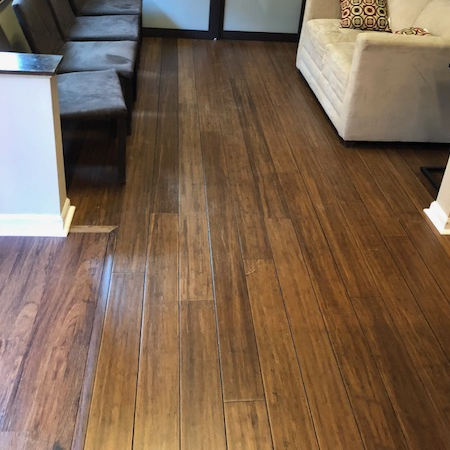
DS Home DR is an Eco-friendly environmentally conscious company. We believe Bamboo is the future of flooring and many other product lines.
Bamboo has nothing but a positive reputation when it comes to the environment. It grows quickly, it doesn’t need pesticides or much water, it pulls carbon dioxide out of the air, and it can be used in a nearly unimaginable range of products. There are now bamboo shirts, skirts, socks, underwear, furniture, paper, plates, sheets, towels, plates, bowls, spoons, kitchen utensils, keyboards, cleaning wipes…practically enough items to outfit an entire house made with bamboo everything.
And when it comes to floors….DS HOME DR installs only the best for our clients!
http://www.inbar.int/bamboo-facts-what-makes-bamboo-a-strategic-resource-for-green-economy-development/
http://www.inbar.int/bamboo-the-ideal-material-for-the-worlds-low-cost-housing-needs/
https://www.amerifirst.com/amerifirst-blog/bid/103922/DIY-Home-Decor-6-Reasons-Why-Bamboo-Flooring-is-Better-than-Timber
Want to learn more about bamboo flooring? Scroll down and read how some types of bamboo flooring is made
Learn about Bamboo Flooring
Learning about the process that is used to make the various forms of bamboo flooring makes it easier to understand how a grass is transformed into a durable and attractive option for flooring. Bamboo flooring is a wonderful alternative to the more traditional hardwood flooring options.
What is Bamboo?
While technically a grass, bamboo is quickly becoming an industry favorite for environmentally friendly wood flooring. Bamboo is a sustainable plant that grows quite quickly, up to four feet per day, and is able to grow well in soil of poor quality. Some of the largest varieties of bamboo can grow to have a diameter of 13 inches and a height of 120 feet within three years. The most common form of bamboo found in Asia is self-propagating and does not need to be treated with herbicides or pesticides to flourish.
While bamboo is usually found in Asia, it is becoming a more common crop throughout the world. With about 1,000 different species thriving in a variety of soils and climates, bamboo has a presence in many areas. As the popularity and demand for this versatile crop increases, the areas where it can be found will also likely increase.
Harvesting Bamboo

Photo Credit: Augupfel
Unlike most hardwood, trees that take decades to be harvestable, bamboo can be harvested in as little as three years, but ideally in four to six years. Harvesting the bamboo does not damage the grass; rather it remains healthy and continues to produce an abundant crop for future harvests. Ideally, bamboo harvests begin in the fall or winter, as this is when the moisture level is lower. Summer harvests can cause the bamboo to fracture during the curing process.
After the Harvest
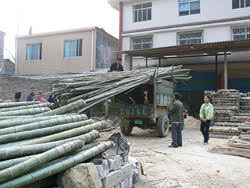 Photo Credit: Ben Burkland/Carolyn Cook
Photo Credit: Ben Burkland/Carolyn Cook
Once harvested, the difficult work of transforming the bamboo from grass to flooring begins. The green outer hull of the bamboo is removed and the stalk is cut into long strips called fillets. At this point, the bamboo strips retain the natural curve of the plant. Milling the bamboo along the outer sides creates a flat strip more suitable for future flooring. The strips are then dried and boiled to remove moisture as well as natural sugars and starches. There are two benefits of boiling the bamboo. The first is that it makes the finished product less desirable to insects such as termites that often infest other wooden products. This termite resistance makes bamboo flooring even more desirable in areas with high termite populations. Secondly, boiling the bamboo makes it less likely to suffer expansion and contraction than hardwood floors in humid climates.
After the boiling and drying are completed it is then possible to darken the bamboo through a process of carbonization, if a color more similar to hardwood flooring is required. Carbonization relies on steam and pressure to darken the bamboo. Colors range from a deep coffee to a light amber. Increasingly, however, consumers are choosing bamboo flooring that has the natural coloring, either stained to retain its natural color or stained to the color of their choice.
Once the initial refinements are completed, the bamboo is then inspected. Inspectors grade the bamboo as either A or B.
Strand-Woven Bamboo Flooring
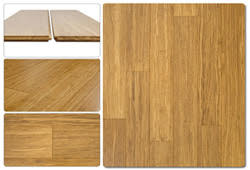
During the milling stage of the bamboo processing, the strands that remain are trimmed from the long bamboo fillets. The use of a byproduct of processing, or what would be considered a waste product from another type of wood, is part of what makes bamboo flooring so environmentally friendly. Intricate patterns are created by weaving the thin strands together and compressing them with a resin to create beautiful flooring. The strand-woven flooring is strong, durable, scratch resistant, UV resistant, moisture resistant, and is about twice as hard as other forms of bamboo flooring.
Vertical and Horizontal Bamboo Flooring
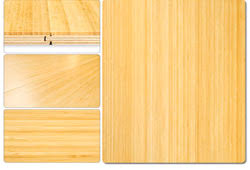
The bamboo fillets are what make up the greatest portion of bamboo flooring. After the boiling process, the strips are again dried in a kiln and then glued together into an either vertical grain or horizontal grain.
The narrow edges of several strips of bamboo are glued together to create the vertical bamboo flooring. These strips are combined and have a thin layer of lamination between them. The finished product has a smooth uniform look, much like traditional hardwood flooring.
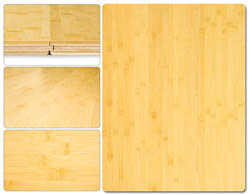
By gluing the wider surfaces together, facing up, horizontal bamboo flooring is created. This style of flooring also uses lamination. The laminating process makes the thickness of the flooring uniform throughout. The finished horizontal flooring randomly displays the knuckles, or growth rings, of the stalk.
Final Stages
With all three types of bamboo flooring, vertical grain, horizontal grain, and strand-woven grain, the final stage involves milling the boards to refine the flooring. The popular tongue and groove system traditionally used in wood flooring is used with bamboo as well. This ensures a smooth surface and snug fit, and creates a product that is comparable in style with hardwood flooring. Several coats of finish with aluminum oxide are applied to the flooring to make the durable material even more resistant to damage from daily use.

